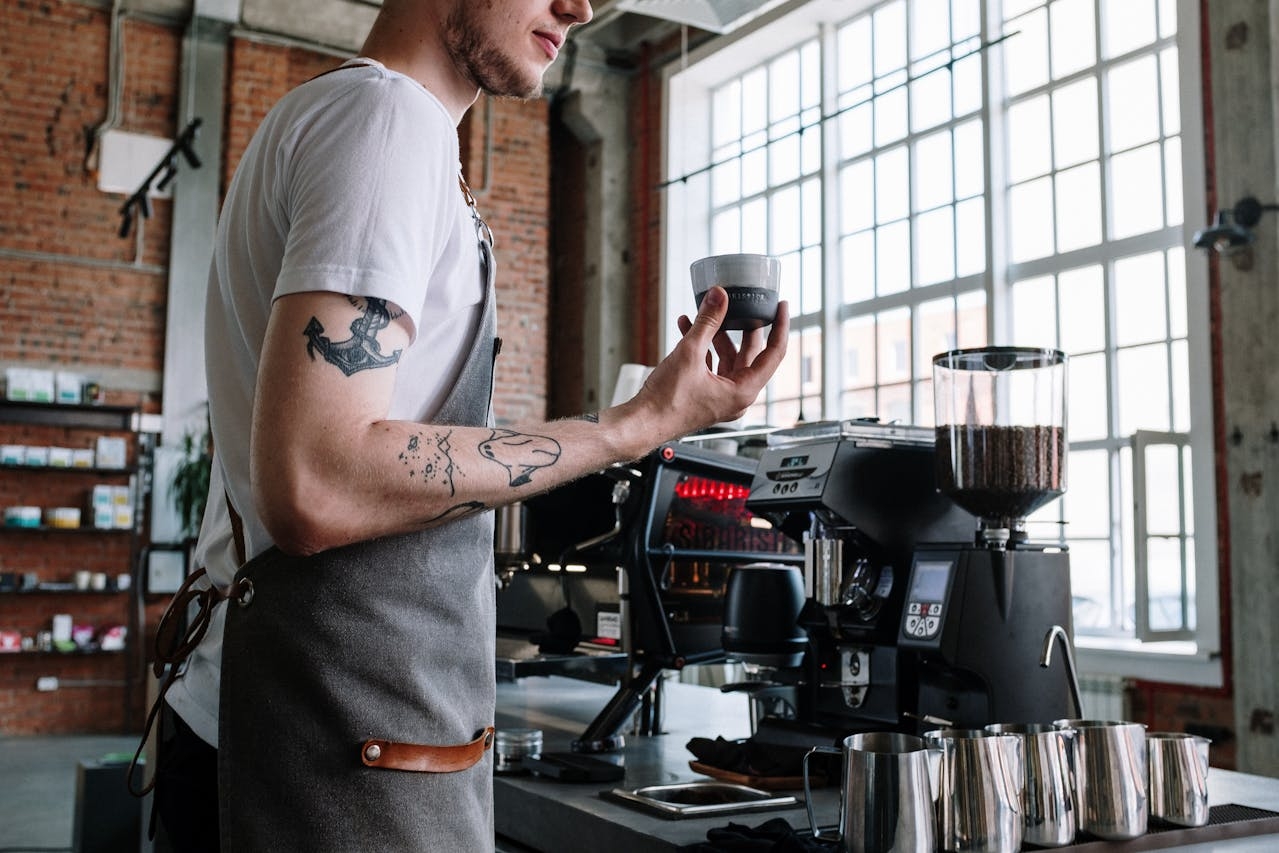How to Start a Cafe with No Money – Smart Bootstrap Strategies
By Nikita Nielsen · 6. March 2024
If you’re searching for a roadmap on how to start a cafe on a low budget, you’ve come to the right place.
It’s true; launching🚀 a cafe without capital is challenging, but not impossible.
This article provides a step-by-step guide on leveraging bootstrap methods, from identifying unique selling points to navigating alternative financing.
While it won’t be easy, with creativity and determination, your cafe aspirations are achievable. Let’s uncover the strategies that can help pave your path to cafe ownership!
Key Takeaways
- Kickstart your cafe on a shoestring budget by mixing smart planning with clever, low-cost tactics like pop-up coffee stands and cosy bookstore corners.
- Create a chill vibe that’s all your own with unique touches, dive into some cool decor, and spread the word with community-focused, down-to-earth marketing.
- Run your cafe without breaking the bank—snap up second hand equipment, keep things simple and efficient, and go green with energy savers. Starting up might be a bit of a juggle, but it’ll all come together in the end!
Laying the Groundwork for a No-Money Cafe Venture
 cafe shop planning
cafe shop planning
Before diving into the cafe scene, it’s essential to have a well-thought-out plan.
A successful cafe business hinges on careful planning paired with an in-depth understanding of the coffee industry.
Acknowledging budget limitations is crucial for ensuring your cost-effective coffee shop can generate revenue on par with traditional cafes.
To achieve financial success without significant investment, consider strategies like collaborating with a local bookstore or launching a mobile coffee cart to mitigate financial overhead.
Identifying Your Cafe’s Unique Selling Proposition
Just like every coffee bean has its unique flavour profile, every cafe needs its Unique Selling Proposition (USP).
This is the one thing that sets your cafe apart from its competitors. Your USP could be:
- Offering a captivating atmosphere
- Exceptional coffee quality
- An innovative loyalty program
- A satisfaction guarantee
Identifying an appropriate USP requires understanding the USPs of competitors, carrying out market research, and utilising this collective data to determine the strongest USP.
Market Research Essentials
Market research is not just a buzzword; it’s a compass that guides the direction of your coffee shop.
Understanding customer consumption habits and budget preferences can help you tailor your cafe concept to meet customer expectations.
Knowing the industry’s trending concepts, customer demands, and market saturation are essential for positioning your new coffee shop effectively.
By analysing competitors’ offerings, pricing, and reputation, you get a clearer picture of how to differentiate your cafe and compete effectively.
Crafting Your Cafe’s Identity
So, you’ve found your unique selling proposition, conducted your market research, and you’re ready to take the next step. It’s time to craft your identity.
This goes beyond just choosing a catchy name, it’s about creating a memorable brand that connects with your target audience.
The ambiance of your cafe is a cornerstone of brand identity, influencing customer perception through:
- decor
- furniture
- lighting
- music
This identity should transcend merely selling coffee and provide an experience that captures hearts and embodies your brand’s passion and creativity.
Blueprint for Success: Drafting a Zero-Cost Business Plan
 cafe shop setup
cafe shop setup
A blueprint for success is essential when starting your cafe. This is where drafting a zero-cost business plan comes into play.
The business plan provides a pathway forward, allowing for a focused and systematic approach to establishing the coffee shop.
Remember, business plans and their underlying business model are flexible and can be adapted to fit different budgets, including the ability to tweak or change the plan to fit a zero-cost budget.
Structuring Your Cafe Business Plan
Your business plan📑 is your roadmap, so make sure it’s well-structured.
It should start with an executive summary that offers a snapshot of the business, including the concept, target market, and financial outlook.
Your market research will come in handy here, establishing a cafe concept that meets customer expectations and achieves market differentiation.
A proposed menu reflecting the preferences of the target market and marketing plans surrounding the Four Ps (product, price, place, and promotions) are also crucial components of the business plan.
Low-Cost Marketing Methods
A small budget doesn’t mean you can’t market your cafe effectively. There are plenty of low-cost marketing methods that can help you get the word out.
By creating an online presence through platforms like Instagram and Facebook, you can engage customers with visually appealing content and regular updates.
Promoting seasonal and high-margin items via social media, alongside engaging with customers on national social media events like ‘National Coffee Day’, can significantly increase engagement and sales.
Innovative Financing Solutions for Aspiring Cafe Owners
 Financing Solutions
Financing Solutions
For those aspiring cafe owners who may not have a treasure chest of savings to dig into, there are innovative financing solutions available.
Crowdfunding campaigns and exploring alternative financing methods are just a few options to consider when looking to open a shop with little or no money beforehand.
Remember, a successful crowdfunding campaign not only raises capital but also increases awareness and interest in the local community, helping to build a solid client base from day one.
Crowdfunding Campaigns: A Path to Free Coffee Capital
Crowdfunding campaigns are like fuel for your cafe dreams.
By setting up a campaign on online platforms like Kickstarter or Indiegogo, individuals can contribute financially to support your project without expecting a financial return on their investment.
But remember, running a successful🎊 crowdfunding campaign requires thorough financial planning, a clear target amount, and a strong marketing strategy that showcases your cafe’s unique qualities.
Alternative Financing: Beyond Traditional Business Loans
If crowdfunding isn’t your cup of tea, there are other alternative financing options you can explore.
Peer-to-peer lending, invoice financing, and revolving credit facilities are just a few examples.
Nonprofit community-based lenders also offer flexible, mission-driven lending options, understanding local community needs.
Scouting the Perfect Spot: Cost-Effective Location Hunting
 Shop Hunting
Shop Hunting
Your cafe’s location is as important as the coffee itself. The perfect spot should be easily accessible, visible, and considerate of local traffic patterns and infrastructure.
But remember, budget constraints frame the reality of location selection, balancing the cost with expected sales.
Creative Venue Ideas
Don’t limit your search to traditional coffee shop venues. Consider shared spaces like restaurant incubators, libraries, or even virtual office spaces.
If you’re up for a bit of adventure, why not consider a coffee stand or a mobile event coffee selling endeavour as a unique café idea?
These options are not only cost-effective but also offer a unique experience for your customers and can be a great way to start your own café business.
Essential Cafe Equipment on a Dime
 Cafe Equipment
Cafe Equipment
Just as a coffee brew requires the right equipment, so does your cafe. You’ll need:
- An espresso machine
- Grinders
- Refrigerators
- Cooking devices
- A POS system
But don’t let the list scare you. There are cost-effective solutions for equipment sourcing like using a small or mobile location, offering a limited but unique menu, or finding partners with flexible payment or financing options.
Sourcing Second Hand Equipment
Buying second-hand can lead to savings of up to 60% on top-quality brand coffee machines, which are refurbished by trained professionals to ensure functionality and adherence to professional standards.
These retailers often provide additional services such as dispatching used coffee machines within 24 hours and assisting with locating specific brands or functionalities if not currently available in their inventory.
Leasing vs. Buying: What’s Best for Your Budget?
When it comes to acquiring equipment, you’ll need to decide between leasing and buying.
Leasing can reduce initial capital expenditures and provide access to modern machines with advanced features.
However, it’s important to note that leasing does not lead to ownership and might result in higher overall costs in the long run.
On the other hand, purchasing coffee equipment offers complete control over machine choice and involves less paperwork than leasing.
Building Your Team: Smart Staffing for Small Coffee Shops
Your team is the driving force behind your coffee cafe’s success🚀.
When recruiting staff for a small coffee shop, prioritise interpersonal skills as these are as critical as food or coffee preparation knowledge and experience.
Hire reliable and passionate employees with outgoing personalities and offer necessary training to maintain high-quality service.
Menu Development: Crafting a Cost-Conscious Coffee Selection
Your menu is the heart of your cafe. A diverse yet cost-conscious selection is key, encompassing not just coffee but also other beverages, snacks, and light meals.
Understanding the cost of ingredients and preparation for each menu item is crucial.
Simplify your offerings by focusing on popular and high-margin items that appeal to a broad customer base, while ensuring the quality and uniqueness of your cafe shine through.
Reducing the initial breadth of the menu can significantly lower startup costs by minimising necessary ingredients and simplifying operations.
Focusing on High-Margin Items
High-margin items are your golden ticket to a profitable cafe shop. Some examples of high-margin items include:
- Flavoured lattes
- Specialty teas
- Hot chocolate
- Homemade lemonade
These items have the potential to enhance profitability.
Pairing baked goods like cakes and pastries with coffee can be extremely lucrative due to popular demand and the high profitability of items like muffins and scones.
Engaging the Community: Grassroots Marketing Efforts
In the world of cafes, your community is your lifeline. Partnering with local businesses like bakeries or bookstores can expand your reach and cross-promote services, potentially attracting new customer segments.
Hosting engaging events such as coffee☕️ tasting sessions and latte art demonstrations can also draw in new customers and foster community engagement.
Collaborations and Partnerships
Collaborations and partnerships are like the perfect blend of coffee beans, creating a unique flavour that sets you apart.
Partnering with local restaurants can provide your cafe access to private rooms or quieter areas in restaurants, offering the benefit of an existing clientele.
Additionally, engaging in cross-promotions with other local businesses can drive customer traffic to both establishments.
Hosting Community Events
Hosting community events is an excellent way to stir up buzz about your cafe.
Events like “New Roast Reveal” tastings or “Cafe Co-Working Days” for local remote workers can provide customers a taste of your cafe’s offerings and draw in new patrons.
Utilising branded materials and influencer marketing to publicise community events effectively raises your cafe’s local profile.
Plus, imagine the Instagram-worthy moments during “Latte Art Throwdowns” or “Espresso Extravaganzas” that can turn attendees into brand ambassadors overnight.
Operating Lean: Streamlining Expenses
Operating lean is all about doing more with less. A focused and small menu not only facilitates quicker service but also streamlines kitchen operations, resulting in reduced day-to-day expenses.
Inventory Management Techniques
Effective inventory management is like a well-timed pour-over, ensuring everything flows smoothly.
Classifying inventory based on purpose, storage, and cycles can make stock management more efficient.
Maintaining complete and accurate stock data is essential for effective inventory management and can be facilitated by using inventory management software.
Energy-Efficiency Practices
Energy efficiency in your coffee shop is like the perfect grind for your beans, it just makes everything better.
Monitoring energy consumption in real-time using smart equipment and energy management systems allows your coffee shop to analyse and optimise energy usage effectively.
Investing in modern, energy-efficient equipment can also reduce energy usage.
From Dream to Reality: Launching Your Coffee Shop
The final step for aspiring cafe owners is launching your cafe venture and making the dream of becoming a cafe or business owner a reality.
Pre-Launch Checklist
Before you open your doors, there’s a pre-launch checklist to tick off.
You must register with the environmental health service at least 28 days before starting to trade.
Also, maintaining a positive attitude throughout the pre-launch process can influence leadership and customer relations.
Grand Opening Tactics
Finally, it’s time for the grand opening🎈! Offer promotional deals such as buy-one-get-one-free coupons and extreme discounts on products during the grand opening.
Organize live music, activities for kids, scavenger hunts, or thematic parties to keep guests entertained.
Summary
Let’s recap!
We’ve journeyed through laying the groundwork, drafting a zero-cost business plan, finding innovative financing solutions, scouting the perfect location, sourcing essential equipment, building your team, crafting a cost-conscious cafe selection, engaging the community, operating lean, and finally launching your cafe.
With passion and perseverance, you can turn your dream of owning a cafe into a reality.
Frequently Asked Questions
Can I run a cafe with no experience?
Opening a cafe without any experience is feasible, but gaining some prior experience in the food industry, particularly at a coffee shop, can greatly increase your chances of success.
How do I start a simple cafe?
Starting a simple cafe requires thorough research on the coffee business, creating a business plan, finding a good location, sourcing suppliers and equipment, creating a menu, marketing your cafe, and finally opening your café.
How profitable is a small cafe?
A small cafe can be profitable, with the average profit margin being about 2.5 percent. However, focusing on increasing sales volume is crucial for boosting profitability.
Is owning a cafe good money?
Owning a cafe can be quite profitable with the potential for substantial gross profit and a steady increase in sales over the years. Just ensure careful planning and budgeting for long-term success.
What is a Unique Selling Proposition (USP) and why is it important for my cafe?
Your cafe’s Unique Selling Proposition (USP) is what makes it stand out from the crowd. It’s essential for setting your business apart and attracting customers in a competitive market.

